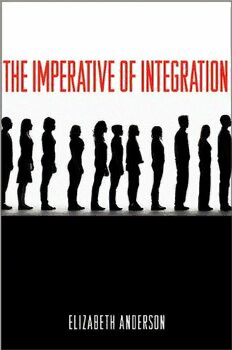
The Imperative of Integration PDF
Preview The Imperative of Integration
THE IMPERATIVE OF INTEGRATION This page intentionally left blank the imperative of integration ELIZABETH ANDERSON PRINCETON UNIVERSITY PRESS PRINCETON AND OXFORD Copyright © 2010 by Princeton University Press Published by Princeton University Press, 41 William Street, Princeton, New Jersey 08540 In the United Kingdom: Princeton University Press, 6 Oxford Street, Woodstock, Oxfordshire OX20 1TW press.princeton.edu All Rights Reserved Library of Congress Cataloging-in-Publication Data Anderson, Elizabeth. The imperative of integration / Elizabeth Anderson. p. cm. Includes bibliographical references and index. ISBN 978-0-691-13981-4 (cloth : alk. paper) 1. Equality—United States. 2. Race discrimination—United States. 3. Segregation— United States. 4. Affirmative action programs—United States. 5. Minorities—United States—Social conditions. 6. United States—Race relations. I. Title. HN90.S6A64 2010 305.896'073—dc22 2010023222 British Library Cataloging-in-Publication Data is available This book has been composed in Sabon Printed on acid-free paper. (cid:102) Printed in the United States of America 1 3 5 7 9 10 8 6 4 2 TO RACHEL AND BENJAMIN This page intentionally left blank CONTENTS Preface ix ONE Segregation and Social Inequality 1 TWO Racial Segregation and Material Inequality in the United States 23 THREE Segregation, Racial Stigma, and Discrimination 44 FOUR Racial Segregation Today: A Normative Assessment 67 FIVE Democratic Ideals and Segregation 89 SIX The Imperative of Integration 112 SEVEN Understanding Affirmative Action 135 EIGHT The Folly and Incoherence of Color Blindness 155 NINE The Ordeal and Promise of Integration 180 Notes193 Index 239 This page intentionally left blank PREFACE I n 1988 I needed to move from Ann Arbor to the Detroit area to spare my partner, a sleep-deprived medical resident at Detroit’s Henry Ford Hospital, a significant commute to work. As I searched for housing in the metropolitan area, I discovered some surprisingly sharp residential pat- terns. In the lovely community of Oak Park, just north of Detroit, blocks of carefully tended middle-class homes with impeccable lawns were di- vided between all-black neighborhoods to the south and all-white, largely Jewish neighborhoods to the north. In Southfield, I examined some apart- ments and homes for rent north of 10 Mile Road, two miles north of the Detroit border. Prospective landlords assured me, a white woman then in her late twenties, that I had no reason to worry about renting there since “we’re holding the line against blacks at 10 Mile Road.” One of them then showed me a home with a pile of cockroaches in the kitchen. Land- lords in the Detroit metropolitan area appeared confident that whites would rather live with cockroaches as housemates than with blacks as neighbors. We decided to rent a house in South Rosedale Park, a stable working/ middle-class Detroit neighborhood with beautiful 1920s brick homes. The tree-lined streets were divided by grassy strips adorned with flowers planted each spring by the residents as a communal activity. We were wel- comed to this effort by our friendly homeowning neighbors. Our neigh- borhood, which was about 80 percent black, was a model of cordial race relations. Matters were different in my place of employment, the University of Michigan in Ann Arbor. At the time a rash of racially hostile incidents targeting black, Latino, Native American, and Asian students was rais- ing alarms across campus. One case involved flyers posted on campus that depicted a lynching along with the statement, “Niggers ought to be hanging from trees.” Although such overtly racist incidents got the most publicity, they did not constitute either the dominant or, in terms of ag- gregate effects, the most damaging mode of undesirable racial interac- tions on campus. More pervasive, insidious, and cumulatively damaging were subtler patterns of racial discomfort, alienation, and ignorant and cloddish interaction, such as classroom dynamics in which white students focused on problems and grievances peculiar to them, ignored what black
